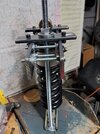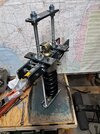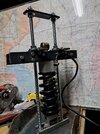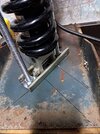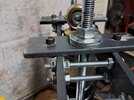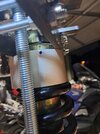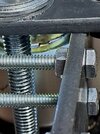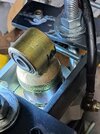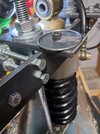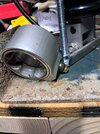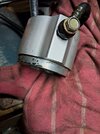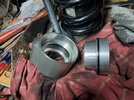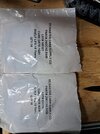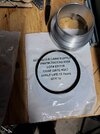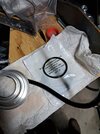FYI People.
When I bought my 2004 ST13 it had no oil in the adjuster, topped it up and all was good. However, it appears to have suddenly failed as there was a lot of oil on the shock and around the lower mount. Time for it to come out the bike...
Shock out the bike.
Remove two 10mm bolts holding adjuster to bracket afer winding it right back off.
removed seat height adjuster to gain better access to top shock nut.
Remove side panel
as my shock had been out before to be serviced the lower bolt was in the "correct" way ie nut on RH side so easy to remove lower bolt without loosening the RH footplate.
Magnet ready to capture top nut before it fell into the bowels of the engine compartment.
A bit of fiddling to remove shock, lowered rear wheel so it just touched exhaust clamps, lift up rear of lower shock yoke, slide it back as far as it will go and it just clears enough to get the top eye out and toward the you then wiggle out after removing adjuster from hose.
Give it all a really good clean to remove dirt ect as you don't want this getting into the seal area later.

I had some machine plate with a handy set of holes and a bracket, with two 10mm stud length which allowed me to compress the shock spring enough to remove the spring clip holding the pre-load slave unit in place and in fact the spring assy.

Oh, nearly forgot. There is a very small allen grub screw you can just see the thread hole in the picture above on the preload slave.
Remove this before compression to get at spring clip as I think it bears on the clip.
Spring clip

Once the clip is removed (bit fiddly but don't force or bend it.
You can relax the spring compression and remove the preload slave unit.

I just kept refilling the adjuster and pushed out the the inner cylinder, have a clean area, rags and paper so not to contaminate the slave unit.
Slave unit separated, easy to do.

Only one seal was leaking on mine but it might be wise to replace both.
From measuring the one leaking on mine 2.5 cross section by 50mm inside Diameter. However I would just take it to a supplier and get a replacement. As it happens I had a suitable one in my box of spare O rings...
Sorry' I forgot to measure the larger one.

Make sure it's spotless, lube it up with clean oil, pop he seals back in and reassemble in reverse order.
I tested mine under a bit of pressure before fitting spring clip back on and it seems all good, so it's back on the bike next.

Wish me luck with getting the shock back in.
hope the above helps someone.
not too bad a job the spring compressor might be the worst bit to source.
EDIT;
All done. Not so bad popping the shock back in.
\v/
When I bought my 2004 ST13 it had no oil in the adjuster, topped it up and all was good. However, it appears to have suddenly failed as there was a lot of oil on the shock and around the lower mount. Time for it to come out the bike...
Shock out the bike.
Remove two 10mm bolts holding adjuster to bracket afer winding it right back off.
removed seat height adjuster to gain better access to top shock nut.
Remove side panel
as my shock had been out before to be serviced the lower bolt was in the "correct" way ie nut on RH side so easy to remove lower bolt without loosening the RH footplate.
Magnet ready to capture top nut before it fell into the bowels of the engine compartment.
A bit of fiddling to remove shock, lowered rear wheel so it just touched exhaust clamps, lift up rear of lower shock yoke, slide it back as far as it will go and it just clears enough to get the top eye out and toward the you then wiggle out after removing adjuster from hose.
Give it all a really good clean to remove dirt ect as you don't want this getting into the seal area later.

I had some machine plate with a handy set of holes and a bracket, with two 10mm stud length which allowed me to compress the shock spring enough to remove the spring clip holding the pre-load slave unit in place and in fact the spring assy.

Oh, nearly forgot. There is a very small allen grub screw you can just see the thread hole in the picture above on the preload slave.
Remove this before compression to get at spring clip as I think it bears on the clip.
Spring clip

Once the clip is removed (bit fiddly but don't force or bend it.
You can relax the spring compression and remove the preload slave unit.

I just kept refilling the adjuster and pushed out the the inner cylinder, have a clean area, rags and paper so not to contaminate the slave unit.
Slave unit separated, easy to do.

Only one seal was leaking on mine but it might be wise to replace both.
From measuring the one leaking on mine 2.5 cross section by 50mm inside Diameter. However I would just take it to a supplier and get a replacement. As it happens I had a suitable one in my box of spare O rings...
Sorry' I forgot to measure the larger one.

Make sure it's spotless, lube it up with clean oil, pop he seals back in and reassemble in reverse order.
I tested mine under a bit of pressure before fitting spring clip back on and it seems all good, so it's back on the bike next.

Wish me luck with getting the shock back in.
hope the above helps someone.
not too bad a job the spring compressor might be the worst bit to source.
EDIT;
All done. Not so bad popping the shock back in.
\v/
Last edited:

